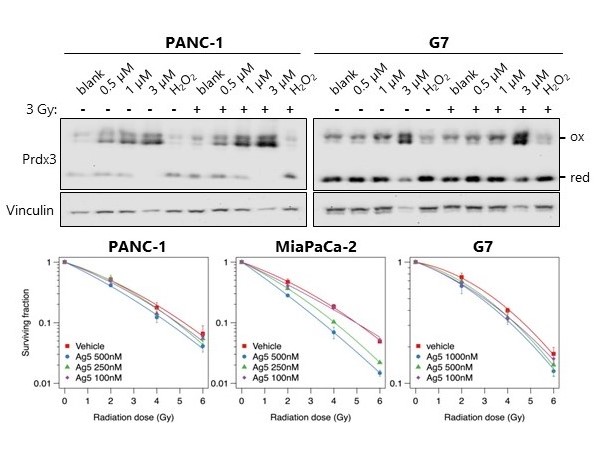Five silver atoms clusters enhance radiation sensitivity of pancreatic and glioblastoma cell lines
PO-2229
Abstract
Five silver atoms clusters enhance radiation sensitivity of pancreatic and glioblastoma cell lines
Authors: Kamila Rosiak-Stec1, Waisse Waissi1, Martin Treder2, Anthony Chalmers1
1Wolfson Wohl Cancer Research Centre, University of Glasgow, School of Cancer Sciences, Glasgow, United Kingdom; 2Arjuna Therapeutics, R&D, Milladoiro, Spain
Show Affiliations
Hide Affiliations
Purpose or Objective
Pancreatic ductal adenocarcinoma (PDAC) and glioblastoma (GBM) are the most devastating solid tumours with 5-year overall survival rates of less than 9%. Treatment of these cancers involves radiotherapy which causes tumour cell death by inducing reactive oxygen species (ROS) and oxidative stress. Elevated activity of thioredoxin (Trx) and glutathione (GSH)-dependent pathways that scavenge ROS in tumour cells contributes to radioresistance. We hypothesised that irreversible inhibition of both pathways could be an effective way to radiosensitise cancer cells. Ag5, comprising clusters of five silver atoms, is a recently developed therapeutic agent that has been demonstrated to selectively kill cells with high levels of ROS by catalyzing the ROS-dependent oxidation of thiol groups on thioredoxins, peroxiredoxins and targets of the glutathione pathway (1). We aimed to determine whether Ag5 clusters enhanced radiation-induced cytotoxicity in PDAC and GBM cell lines in vitro.
Material and Methods
Human PDAC (PANC-1 and MIA PaCa-2) and GBM stem-like cells (G7) cell lines were exposed to Ag5 (0.1 - 3 µM) alone or in combination with radiation (0 - 6Gy), using different culture conditions and treatment schedules. Clonogenic survival assays were used to assess the cytotoxic and radiosensitising properties of Ag5. The redox state of Trx-dependent peroxide reductase (Prdx3), a key regulator of mitochondrial oxidative stress, was determined by Western Blot.
Results
In vitro, Ag5 clusters exhibited single agent cytotoxicity in PDAC (IC50 = 429 nM for PANC-1) and GBM (IC50 = 311 nM for G7) cell lines as well as radiosensitising activity. Sensitiser enhancement ratio (SER) values calculated from clonogenic survival of cells treated for 1 hour with Ag5 at 0.5 µM was 1.51 for MIA PaCa-2, 1.21 for PANC-1, and 1.095 for G7 (Fig. 1). Effectiveness of Ag5 was only marginally improved with extended treatment time. SER values correlated with rapid onset of Prdx3 oxidation confirming engagement of the Trx antioxidant system (Fig. 1). Finally, Ag5 was more potent as a single agent and radiosensitiser under serum-free conditions.

Conclusion
Our results demonstrate that targeting glutathione and thioredoxin pathways is a viable strategy to overcome radiation resistance ‘difficult to treat’ tumours such as PDAC and GBM. In vivo studies are planned to validate clinical potential.